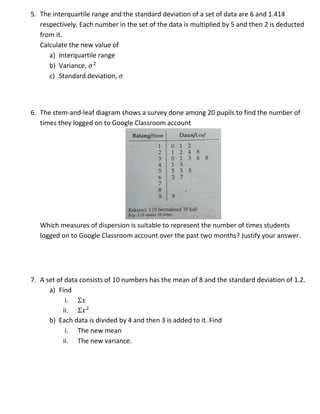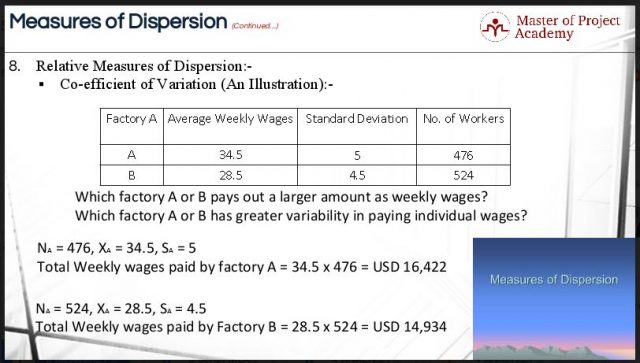The higher is the dispersion or variability of data the larger will be. Measures of Variation or Dispersion of a data provide an idea of how observations spread out or scattered throughout the data.

Absolute And Relative Measures Of Dispersion Statistical Methods Measurements Words
The difference between the maximum and minimum values of each group gives us the range.

. Relationship between MeanMedian and Mode. The table helps measures the dispersion ie. Measures of Central Tendency MeanMedian and Mode for Ungrouped Data Basic Statistics 2.
It is the average of all the values given in a set of data. O Data Set 2 5 2 3 5 4 7 O Modes 2 and 5 11. Hence standard deviation is an important tool used by statisticians to measure how far or how close are the points in a data group from its.
Now consider the situation where we want to collect data on the test scores of five such classes ie. Quartile deviation is one of the measures of dispersionBefore getting into a deeper understanding lets recall quartiles and how we can define them. It is the difference between the value of smallest observation and largest.
Standard Deviation simply stated is the measure of the dispersion of a group of data from its meanIn other words it measures how much the observations differ from the central mean. We can find the mode by counting the number of times each value occurs in a data set. We will first choose a suitable class interval for the above data then we will enter the frequency values to complete the table.
MEASURES OF DISPERSION 77 Q 1 is the size of n1 th 4 value. In statistics class 11 the importance of statistics in studying the measures of dispersion and the methods of calculating the grouped and ungrouped data has been explainedIn applied mathematics statistics is a branch that deals with the collection organization and interpretation of data. Mean deviation is a measure of dispersion.
In this chapter terminologies like statistics limit of the class class interval primary and secondary data variable or variate frequency discrete frequency distribution. As the values are already arranged in ascending order it can be seen that Q 1 the 3rd value is 29. Relative dispersion coefficient of variation.
It helps to determine the variability of data with respect to the. Operations on Sets. 1 The arithmetic mean.
On the other hand if data consists of individual data points it is called ungrouped data. Ungrouped data Example 1 Calculate range and QD. SD is the positive square root of variance.
The formula to calculate the range of a data set is given below. SS f x 2 x for grouped data. Statistics Class 11 Notes.
For estimating the scatter or dispersion in data there are four ways mentioned in Statistics class 11 by which we can gather that. Correlation meaning and properties scatter diagram. So for the previous example we can calculate range as Range 8-2 6.
It is a single number of value which can be considered typical in a set of data as a whole. Is Mean Deviation a Measure of Dispersion. Use the data to make a frequency table.
Measures of Dispersion absolute dispersion standard deviation. Measures of Dispersion for Ungrouped Data. O This happens when two or more elements occur with equal frequency in the data set.
A measure of dispersion is a quantity that is used to check the variability of data about an average value. Range Maximum value Minimum value. However we can define the formulas to find the range of grouped and ungrouped data.
So you have to first calculate variance to find SD. Frequency is nothing but the number of times an event occurs in a given scenario. It measures the absolute variability of a distribution.
Statistical Tools and Interpretation. Quartile deviation measures the absolute level of dispersion and is not affected by the extreme values. Standard Deviation For Grouped Data.
41 58 41 54 49 46 52 53 55 52. SD shortcut method is Assumed Mean formula-Here d is x - A and A is the assumed mean. Lets look at how to determine the Standard Deviation of grouped and ungrouped data as well as the random variables Standard Deviation.
Data can be of two types - grouped and ungrouped. 1st Term Test. Mean is capable of further algebraic treatment so that different other statistics like dispersion correlation skew-ness.
Sk b Bowleys coefficient of skewness sk b 3 1 3 2 2 1 Q Q Measures of skew ness sk p Pearsons coefficient of skewness sk p S dard Deviation Mean Mode tan Measures of skew ness SS x Sum of Squares SS x 2 x for ungrouped data. The range is the difference between higher and lower values of the given data. Network in Graph Theory.
There are three measures of central tendency such as. Range of Ungrouped Data. O Data Set 2 5 9 3 5 4 7 O Mode 5 O Example.
Measures of Central Tendency In laymans term a measure of central tendency is an AVERAGE. However it gives the spread of data about the different measures of central tendency such as mean median or mode. In this method we can calculate mean from the ungrouped data and the formula for calculating mean from un-grouped data.
Topics such as range mean deviation Measures of dispersion Standard deviation Mean deviation for ungrouped data etc are dealt with in detail in this chapter. What are the Measures of Central Tendency and Dispersion. Measures of correlation Karl Pearsons method two variables ungrouped data.
Mode is the value which has the highest frequency. Mean median and mode. And the relative measure with reference to quartile deviation is known as the coefficient of quartile deviation.
Introduction to Index Numbers meaning. Calculate the mean deviation for grouped data. Measures of Dispersion.
Quartiles are the values that divide a list of numerical data into three-quarters such as Q 1 Q 2 and Q 3The middle part of the three quarters measures the central point of distribution and shows the data values near the. It is a method of calculating the central tendency of a scattered dataset. The mean deviation is a method that measures the dispersion of the elements of a set respecting to the arithmetic mean.
For this we shall discuss Measures of Dispersion. In statistics the difference between the highest and lowest observations in a given data is called its Range. Dispersion is a measure which gives an idea about the scatteredness of the values.
A frequency distribution such as the one above is called an ungrouped frequency distribution table. O The Range for a data set is the difference between the largest value and smallest value contained in the data set. Measures of central tendency and location ie.
N being 11 Q 1 is the size of 3rd value. From the table we can observe the number of times the data appears in the data using frequency. 20 25 29 30 35 39 41.
1 2 f f x x s for grouped data. Range variance and standard deviation. The mode is the number that appears most frequently in a set of data.
Different Measures of Dispersion are. MODE It is the value which occur the maximum number of times in a data. Mean deviation can be calculated for both grouped and ungrouped data.
Graphs of Motion. Median is the most middle value in a set of. Of the following observations.
When data is expressed in the form of class intervals it is known as grouped data. Standard Deviation measures the variability or dispersion of the data. Standard Deviation is the measure of the dispersion of data from its mean.
Linear Inequalities in Two Variables. Statistics for Economics Unit 3. Quartile deviation can be calculated for both the grouped data and the ungrouped data.
To find this deviation in an ungrouped data is not that complicated but to calculate the mean absolute deviation in grouped data is a little more complex because we have to do more steps. It takes into account ungrouped data and calculates the frequency for each observation singularly.

Measures Of Dispersion Of Ungrouped Data

Measures Of Dispersion For Ungrouped Data In Frequency Table Range And Interquartile Range Youtube

0 Comments